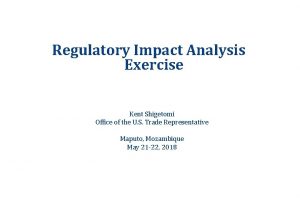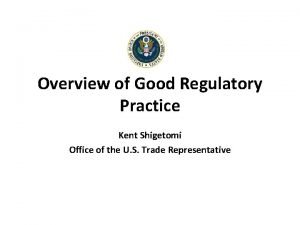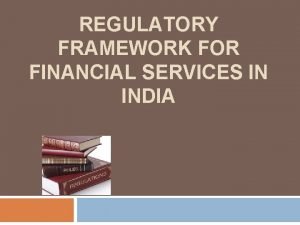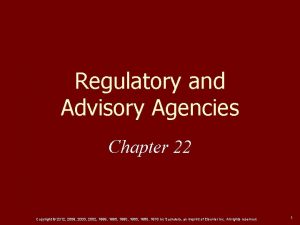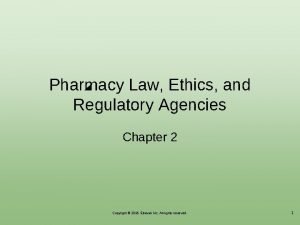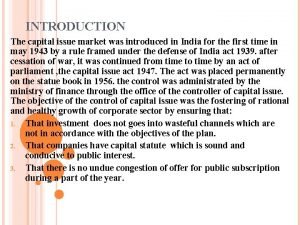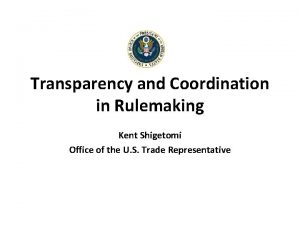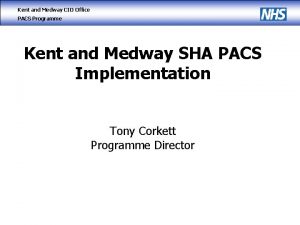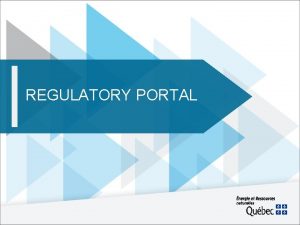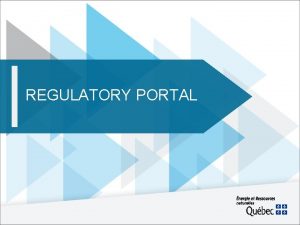Overview of Good Regulatory Practice Kent Shigetomi Office






















- Slides: 22

Overview of Good Regulatory Practice Kent Shigetomi Office of the U. S. Trade Representative

Overview • • • What is Good Regulatory Practice? Why is GRP important? What are the elements of GRP? How do you evaluate or measure GRP? GRP in Trade Agreements

What is Good Regulatory Practice? GRP refers to internationally recognized processes and procedures that can be used to improve the quality and cost-effectiveness of domestic regulations

Good Regulatory Practice GRPs include administrative procedures that govern intragovernmental coordination of rulemaking activity, impact assessment, regulatory transparency, participation, and accountability.

Why is GRP Important? 2012 Recommendation of the Council of the OECD on Regulatory Policy and Governance “The financial crisis, and the pace of social change and environmental challenges highlight the importance of sound regulatory frameworks as a basic condition for well-functioning markets and societies, protecting the environment and the promotion of economic growth. ”

2012 Recommendation of the Council of the OECD on Regulatory Policy and Governance • Sets out the measures that governments should take to support the implementation and advancement of systemic regulatory reform to deliver regulations that meet public policy objectives and will have a positive impact on the economy and society. • These measures are integrated in a comprehensive policy cycle in which regulations are designed, assessed and evaluated ex ante and ex post, revised and enforced at all levels of government, supported by appropriate institutions.

2012 Recommendation of the Council of the OECD on Regulatory Policy and Governance • Sets out 12 recommendations that are elaborated in an Annex. • Examples: – Whole of government approach (#1) – Open government, including transparency and public participation (#2) – Integrate regulatory impact analysis as early as possible (#4)

2011 APEC Leaders Statement: The Honolulu Declaration • Recognizes that regulatory reform can “boost productivity and job creation” while protecting the environment, public health, safety, and security. • As trade and investment flows increase, greater alignment is required to avoid barriers to growth and employment.

What are the Elements of GRP? Three areas at the core of the “better regulation” agenda successfully applied in countries with different economic strategies, legal systems, and administrative cultures: • Internal coordination of rulemaking activity, particularly the ability to manage regulatory reform and coordinate with trade and competition officials • Regulatory impact assessment (RIA), particularly the capacity to ensure that better policy options are chosen by establishing a systematic and consistent framework for assessing the potential impacts of government action, including impacts on trade. • Public consultation mechanisms to improve transparency, such as “publication for comment” and other practices that allow wide access, and the quality of consultation mechanisms

2014 APEC Report: Key Elements of GRP • • • Institutional Design of Rulemaking Activity Transparency and Public Consultation Activity Regulatory Impact Assessment International Regulatory Cooperation Extended Policy Options of GRP

Internal Coordination of Rulemaking Activity • Government bodies engaged in regulation are diverse: health, economic, public services • Internal coordination across agencies is critical • OECD recommendation: whole of government approach to ensure that the economic, social, and environmental benefits justify the costs

Regulatory Impact Assessment Contributes to more informed policy decisions and promotes economic efficiency by calculating costs and benefits and regulating only where necessary • Comprehensive approach • Rigor of Analysis • Accountability

Public Consultation and Transparency and accountability help address concerns about undue influence and allows all interested parties to be heard. • Accountability • Engagement and buy-in • Efficiency

How do you evaluate or measure GRP? APEC-OECD Checklist on Regulatory Reform • There is no single model of regulatory reform, but this does not mean that standards, goals and well-structured institutions do not matter. • The checklist is a voluntary tool that member economies may use to evaluate their respective regulatory reform efforts.

APEC-OECD Checklist on Regulatory Reform • Four parts to the checklist • (A) Horizontal questionnaire • Three specific policy areas: – (B) Regulatory policies – (C) Competition policies – (D) Market openness policies

Horizontal Questionnaire • To what extent is there an integrated policy for regulatory reform that sets out principles dealing with regulatory, competition and market openness policies? • To what extent do regulation, competition and market openness policies avoid discrimination between like goods, services, or service suppliers in like circumstances, whether foreign or domestic?

GRP and Trade 2011 APEC Leaders’ Declaration: “In addition, as trade and investment flows become more globalized, greater alignment in regulatory approaches, including to international standards, is necessary to prevent needless barriers to trade from stifling economic growth and employment. ”

GRP and U. S. Trade Agreements • GRPs are an important element of U. S. FTAs and trade and investment framework agreements, where we seek commitments to GRPs and establish dedicated groups to strengthen cooperation. • Generally covered within individual chapters – Publication, Notification and Administration of Laws” (NAFTA) or “Transparency” (others) – Technical Barriers to Trade – Government Procurement – Elements of regulatory cooperation

U. S. -EAC Cooperation Agreement Article 3. 1 Recognizing the benefits to trade of WTO-consistent regulatory regimes, the Parties shall work together to: … (f) support the development and implementation of good regulatory practices in EAC Partner States, including, but not limited to: (i) transparency in the preparation, adoption, and application of technical regulations, standards, and conformity assessment procedures; (ii) evidence-based decision making; and (iii) mechanisms and methods for periodic review of technical regulations and conformity assessment procedures;

GRP and Trade: The TPP and T-TIP • Trans-Pacific Partnership (TPP): Regulatory Coherence is one of four “horizontal” issues, along with competitiveness and business facilitation, small and medium-sized enterprises, and development • Transatlantic Trade and Investment Partnership: Includes a chapter on Regulatory Coherence and Transparency

TPP TBT Chapter • Includes many new features, building on those in the TBT Agreement and earlier FTAs. • New transparency requirements, including public consultation requirements early in the development of new measures, enabling traderelated concerns to be vetted and addressed before new measures are finalized • Requirements ensuring that information on regulatory decision making is publicly available

TPP TBT Chapter • Greater clarification that companies will need to have their goods undergo conformity assessment procedures only once before being able to sell them in TPP markets. • Annexes on specific products: wine and distilled spirits, ICT products, pharmaceuticals, cosmetics, medical devices, food products, organics
 Kent shigetomi
Kent shigetomi Kent shigetomi
Kent shigetomi Good regulatory practice guidelines
Good regulatory practice guidelines Kent state cost of attendance
Kent state cost of attendance Good thoughts good deeds good actions
Good thoughts good deeds good actions Hi good morning video
Hi good morning video Cómo se dice buenas tardes
Cómo se dice buenas tardes Nothing compares to your embrace
Nothing compares to your embrace Good afternoon morning
Good afternoon morning Factory office plan
Factory office plan Unit 3 assessing risk in sport
Unit 3 assessing risk in sport Dispositional framework vs regulatory framework
Dispositional framework vs regulatory framework Regulatory signs examples
Regulatory signs examples Regulatory framework of financial services
Regulatory framework of financial services Chapter 22 regulatory and advisory agencies
Chapter 22 regulatory and advisory agencies Chapter 2 pharmacy law ethics and regulatory agencies
Chapter 2 pharmacy law ethics and regulatory agencies Phenolic disinfectants are milady
Phenolic disinfectants are milady Functions of sebi
Functions of sebi Regulatory institutions in indian financial system
Regulatory institutions in indian financial system Regulatory change management process
Regulatory change management process Regulatory functions of sebi
Regulatory functions of sebi Managing diversity and regulatory challenges
Managing diversity and regulatory challenges Chapter 2 signs signals and roadway markings
Chapter 2 signs signals and roadway markings
